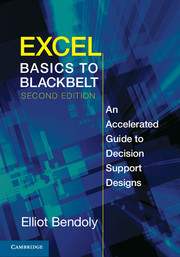Book contents
- Frontmatter
- Contents
- Associated Links
- Preface
- Section 1 Getting Oriented
- 1 Necessary Foundations for Decision Support
- 2 The Development Environment
- 3 Getting Data: Acquisition, Linkage, and Generation
- Section 2 Harvesting Intelligence
- Section 3 Leveraging Dynamic Analysis
- Section 4 Advanced Automation and Interfacing
- Glossary of Key Terms
- Appendix: Shortcut (Hot Key) Reference
- Index
1 - Necessary Foundations for Decision Support
Published online by Cambridge University Press: 05 August 2013
- Frontmatter
- Contents
- Associated Links
- Preface
- Section 1 Getting Oriented
- 1 Necessary Foundations for Decision Support
- 2 The Development Environment
- 3 Getting Data: Acquisition, Linkage, and Generation
- Section 2 Harvesting Intelligence
- Section 3 Leveraging Dynamic Analysis
- Section 4 Advanced Automation and Interfacing
- Glossary of Key Terms
- Appendix: Shortcut (Hot Key) Reference
- Index
Summary
People make decisions every several minutes. Some of these decisions may appear trivial, such as what shirt to wear or what to have for lunch. Some decisions may appear routine: Should I provide my PIN number? Should I respond to a question from a colleague? Others are more complex: Should I recommend that my client invest in a particular firm? Should I offer to take on additional work? Should I purchase a new technology? Should I recommend a settlement in a lawsuit? These aren't simple questions and they don't have obvious answers and outcomes. Sometimes, we need help with decisions. The sources of help can vary, but increasingly these sources tend to have two things in common: analytical strength and ease of use. These sources of assistance often take the form of prepackaged off-the-shelf software tools. However, they can also be uniquely customized, and more and more frequently, this customization is being developed by individual users.
We can describe these tools by listing their potential benefits. Some of them appear in Figure 1.1. For many developers and analysts, only a few of those attributes are listed important. For others, the full complement of potential benefits must be considered. Toward this goal, visualization is very important. Indeed, one could argue that the application of visualization in data analysis is critical to the development of Decision Support Systems (DSS).
- Type
- Chapter
- Information
- Excel Basics to BlackbeltAn Accelerated Guide to Decision Support Designs, pp. 3 - 6Publisher: Cambridge University PressPrint publication year: 2013



